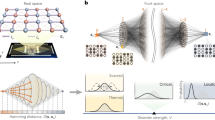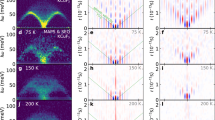Abstract
Interacting many-body quantum systems show a rich array of physical phenomena and dynamical properties, but are notoriously difficult to study: they are analytically challenging and exponentially hard to simulate on classical computers. Small-scale quantum information processors hold the promise to efficiently emulate these systems, but characterizing their dynamics is experimentally difficult, requiring probes beyond simple correlation functions and multi-body tomographic methods. Here we demonstrate the measurement of out-of-time-ordered correlators—one of the most effective tools for studying quantum system evolution and processes like quantum thermalization. We implement a 3 × 3 two-dimensional hard-core Bose–Hubbard lattice with a superconducting circuit, study its time reversibility by performing a Loschmidt echo, and measure out-of-time-ordered correlators that enable us to observe the propagation of quantum information. A central requirement for our experiments is the ability to coherently reverse time evolution, which was achieved with a digital–analogue simulation scheme. In the presence of frequency disorder, we observe that localization can partially be overcome with more particles present—a possible signature of many-body localization in two dimensions.
This is a preview of subscription content, access via your institution
Access options
Access Nature and 54 other Nature Portfolio journals
Get Nature+, our best-value online-access subscription
$29.99 / 30 days
cancel any time
Subscribe to this journal
Receive 12 print issues and online access
$209.00 per year
only $17.42 per issue
Buy this article
- Purchase on Springer Link
- Instant access to full article PDF
Prices may be subject to local taxes which are calculated during checkout




Similar content being viewed by others
Data availability
The data that support the findings of this study are available from the corresponding author upon reasonable request.
Code availability
The code used for numerical simulations and data analyses is available from the corresponding author upon reasonable request.
References
Deutsch, J. M. Quantum statistical mechanics in a closed system. Phys. Rev. A 43, 2046–2049 (1991).
Srednicki, M. Chaos and quantum thermalization. Phys. Rev. E 50, 888–901 (1994).
Rigol, M., Dunjko, V. & Olshanii, M. Thermalization and its mechanism for generic isolated quantum systems. Nature 452, 854–858 (2008).
Neill, C. et al. Ergodic dynamics and thermalization in an isolated quantum system. Nat. Phys. 12, 1037–1041 (2016).
Blok, M. et al. Quantum information scrambling on a superconducting qutrit processor. Phys. Rev. X 11, 021010 (2021).
Mi, X. et al. Information scrambling in quantum circuits. Science https://doi.org/10.1126/science.abg5029 (2021).
Landsman, K. A. et al. Verified quantum information scrambling. Nature 567, 61–65 (2019).
Joshi, M. K. et al. Quantum information scrambling in a trapped-ion quantum simulator with tunable range interactions. Phys. Rev. Lett. 124, 240505 (2020).
Peres, A. Stability of quantum motion in chaotic and regular systems. Phys. Rev. A 30, 1610–1615 (1984).
Yan, B. & Sinitsyn, N. A. Recovery of damaged information and the out-of-time-ordered correlators. Phys. Rev. Lett. 125, 040605 (2020).
Swingle, B. Unscrambling the physics of out-of-time-order correlators. Nat. Phys. 14, 988–990 (2018).
Campisi, M. & Goold, J. Thermodynamics of quantum information scrambling. Phys. Rev. E 95, 062127 (2017).
Kjaergaard, M. et al. Superconducting qubits: current state of play. Annu. Rev. Condens. Matter Phys. 11, 369–395 (2020).
Gärttner, M. et al. Measuring out-of-time-order correlations and multiple quantum spectra in a trapped-ion quantum magnet. Nat. Phys. 13, 781–786 (2017).
Li, J. et al. Measuring out-of-time-order correlators on a nuclear magnetic resonance quantum simulator. Phys. Rev. X 7, 031011 (2017).
Wei, K. X., Ramanathan, C. & Cappellaro, P. Exploring localization in nuclear spin chains. Phys. Rev. Lett. 120, 070501 (2018).
Niknam, M., Santos, L. F. & Cory, D. G. Sensitivity of quantum information to environment perturbations measured with a nonlocal out-of-time-order correlation function. Phys. Rev. Res. 2, 013200 (2020).
Lamata, L., Parra-Rodriguez, A., Sanz, M. & Solano, E. Digital-analog quantum simulations with superconducting circuits. Adv. Phys. X 3, 1457981 (2018).
Palmer, R. Broken ergodicity. Adv. Phys. 31, 669–735 (1982).
Huse, D. A., Nandkishore, R. & Oganesyan, V. Phenomenology of fully many-body-localized systems. Phys. Rev. B 90, 174202 (2014).
Nandkishore, R. & Huse, D. A. Many-body localization and thermalization in quantum statistical mechanics. Annu. Rev. Condens. Matter Phys. 6, 15–38 (2015).
Roushan, P. et al. Spectroscopic signatures of localization with interacting photons in superconducting qubits. Science 358, 1175–1179 (2017).
Altman, E. Many-body localization and quantum thermalization. Nat. Phys. 14, 979–983 (2018).
Alet, F. & Laflorencie, N. Many-body localization: an introduction and selected topics. C. R. Phys. 19, 498–525 (2018).
Lukin, A. et al. Probing entanglement in a many-body–localized system. Science 364, 256–260 (2019).
Abanin, D. A., Altman, E., Bloch, I. & Serbyn, M. Colloquium: many-body localization, thermalization, and entanglement. Rev. Mod. Phys. 91, 021001 (2019).
Chiaro, B. et al. Direct measurement of non-local interactions in the many-body localized phase. Preprint available at https://arxiv.org/abs/1910.06024 (2020).
Anderson, P. W. Absence of diffusion in certain random lattices. Phys. Rev. 109, 1492–1505 (1958).
Koch, J. et al. Charge-insensitive qubit design derived from the Cooper pair box. Phys. Rev. A 76, 042319 (2007).
Yanay, Y., Braumüller, J., Gustavsson, S., Oliver, W. D. & Tahan, C. Two-dimensional hard-core Bose–Hubbard model with superconducting qubits. npj Quantum Inf. 6, 58 (2020).
Blais, A., Huang, R.-S., Wallraff, A., Girvin, S. M. & Schoelkopf, R. J. Cavity quantum electrodynamics for superconducting electrical circuits: an architecture for quantum computation. Phys. Rev. A 69, 062320 (2004).
Wallraff, A. et al. Strong coupling of a single photon to a superconducting qubit using circuit quantum electrodynamics. Nature 431, 162–167 (2004).
Swingle, B., Bentsen, G., Schleier-Smith, M. & Hayden, P. Measuring the scrambling of quantum information. Phys. Rev. A 94, 040302 (2016).
Sánchez, C. et al. Perturbation independent decay of the Loschmidt echo in a many-body system. Phys. Rev. Lett. 124, 030601 (2020).
Lorenz, E. The Essence of Chaos (Univ. of Washington Press, 1993).
Prosen, T., Seligman, T. H. & Žnidarič, M. Theory of quantum Loschmidt echoes. Prog. Theor. Phys. Supp. 150, 200–228 (2003).
McKay, D. C., Wood, C. J., Sheldon, S., Chow, J. M. & Gambetta, J. M. Efficient Z gates for quantum computing. Phys. Rev. A 96, 022330 (2017).
Hill, S. & Wootters, W. K. Entanglement of a pair of quantum bits. Phys. Rev. Lett. 78, 5022–5025 (1997).
Ma, R. et al. A dissipatively stabilized Mott insulator of photons. Nature 566, 51–57 (2019).
Yan, Z. et al. Strongly correlated quantum walks with a 12-qubit superconducting processor. Science 364, 753–756 (2019).
Gong, M. et al. Quantum walks on a programmable two-dimensional 62-qubit superconducting processor. Science 372, 948–952 (2021).
Karamlou, A. H. et al. Quantum transport and localization in 1D and 2D tight-binding lattices. Preprint available at https://arxiv.org/abs/2107.05035 (2021).
Campbell, D. L. et al. Universal nonadiabatic control of small-gap superconducting qubits. Phys. Rev. X 10, 041051 (2020).
Wigner, E. & Jordan, P. Über das Paulische Äquivalenzverbot. Z. Phys. 47, 631–651 (1928).
Shenker, S. H. & Stanford, D. Black holes and the butterfly effect. J. High Energ. Phys. 2014, 67 (2014).
Hayden, P. & Preskill, J. Black holes as mirrors: quantum information in random subsystems. J. High Energ. Phys. 2007, 120 (2007).
Acknowledgements
We are grateful to P. M. Harrington, A. D. Paolo, S. Muschinske and B. Swingle for insightful discussions, and M. Pulido and C. Watanabe for administrative assistance. M.K. acknowledges support from the Carlsberg Foundation during part of this work. A.H.K. acknowledges support from the NSF Graduate Research Fellowships Program. This research was funded in part by the US Army Research Office Grant W911NF-18-1-0411 and the Assistant Secretary of Defense for Research & Engineering under Air Force contract no. FA8721-05-C-0002. Opinions, interpretations, conclusions and recommendations are those of the authors and are not necessarily endorsed by the US government.
Author information
Authors and Affiliations
Contributions
J.B., A.H.K., Y.Y., C.T. and W.D.O. conceived the experiment. Y.Y. developed the pulse sequences for rewinding time and extracting OTOCs and generated the numerical simulations of the OTOCs. J.B. and A.H.K. performed the experiments with theoretical support from Y.Y. J.B., A.H.K., B.K., M.K., Y.S., A.V., R.W. and S.G. developed the experiment control tools used in this work. D.K., A.M., B.N. and J.Y. fabricated the 3 × 3 qubit array. T.P.O., S.G., C.T. and W.D.O. provided experimental oversight and support. All the authors contributed to the discussions of the results and to the development of the manuscript.
Corresponding author
Ethics declarations
Competing interests
The authors declare no competing interests.
Additional information
Peer review information Nature Physics thanks Arghavan Safavi-Naini, Lea Santos and the other, anonymous, reviewer(s) for their contribution to the peer review of this work.
Publisher’s note Springer Nature remains neutral with regard to jurisdictional claims in published maps and institutional affiliations.
Supplementary information
Supplementary Information
Supplementary Sections 1–10, Figs. 1–12 and Tables 1 and 2.
Rights and permissions
About this article
Cite this article
Braumüller, J., Karamlou, A.H., Yanay, Y. et al. Probing quantum information propagation with out-of-time-ordered correlators. Nat. Phys. 18, 172–178 (2022). https://doi.org/10.1038/s41567-021-01430-w
Received:
Accepted:
Published:
Issue Date:
DOI: https://doi.org/10.1038/s41567-021-01430-w
This article is cited by
-
Quantum many-body simulations on digital quantum computers: State-of-the-art and future challenges
Nature Communications (2024)
-
Many-body quantum chaos in stroboscopically-driven cold atoms
Communications Physics (2023)
-
Tunable itinerant spin dynamics with polar molecules
Nature (2023)
-
Observation of critical phase transition in a generalized Aubry-André-Harper model with superconducting circuits
npj Quantum Information (2023)
-
Charge transport, information scrambling and quantum operator-coherence in a many-body system with U(1) symmetry
Journal of High Energy Physics (2023)



